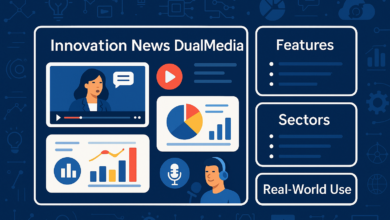Develop Oxzep7 Software: Boosting Team Productivity and Innovation

In today’s fast-paced digital landscape, having the right tools can be the difference between lagging behind and leading in innovation. One such powerful solution is Oxzep7—a software system designed to streamline operations, enhance team collaboration, and increase workplace productivity. When you develop Oxzep7 software, you’re not just creating another tool; you’re empowering organizations to work smarter, faster, and more cohesively.
Oxzep7 isn’t just about function—it transforms how businesses interact, analyze, and execute their goals. From real-time updates to seamless integrations, this software revolutionizes workflows across industries.
The Purpose Behind Oxzep7
The main goal when you develop Oxzep7 software is to create a platform that enhances productivity by eliminating common roadblocks like miscommunication, scattered data, and inefficient task management. With its user-friendly interface and powerful performance tools, Oxzep7 allows teams to collaborate with ease and deliver projects more efficiently.
Users consistently report improved communication and streamlined operations after implementing Oxzep7. Its real-time capabilities ensure that every team member is on the same page, reducing project delays and misunderstandings.
Key Features That Drive Productivity
1. Intuitive User Interface
One of Oxzep7’s major strengths is its simplicity. A clean, intuitive interface allows users at all levels of tech familiarity to navigate effortlessly. Dashboards can be customized to meet specific project needs, making it easier for teams to visualize data and prioritize tasks.
2. Seamless Collaboration Tools
When you develop Oxzep7 software, collaborative features like team boards, shared dashboards, and instant updates play a crucial role. These tools keep all stakeholders informed and aligned with the project’s direction and progress.
3. Customizable Workflow
Oxzep7 adapts to a wide range of industries. Whether you’re in healthcare, tech, manufacturing, or marketing, the software allows teams to customize modules and workflows that match their unique processes. This flexibility is key to ensuring long-term usability.
4. Smart Integration Capabilities
Another compelling reason to develop Oxzep7 software is its ability to integrate seamlessly with other applications. Existing tools like CRM systems, task managers, and analytics platforms can be synchronized for improved functionality.
5. Real-Time Project Tracking
Transparency is a major asset in any business environment. With features like real-time project tracking, teams can monitor progress, detect issues early, and make informed decisions quickly.
The Development Process
Creating Oxzep7 involves a strategic and well-planned development cycle that ensures the final product is both robust and adaptable.
Initial Planning
Understanding user needs and gathering stakeholder input is the first step. Developers work closely with users to determine which functionalities will provide the most value. This early collaboration ensures that Oxzep7 addresses real-world challenges from the start.
Selecting the Right Tools
To develop Oxzep7 software, teams typically use programming languages like Python and JavaScript. Agile development methodologies are preferred, as they support iterative changes and flexible updates. Incorporating project management and version control systems ensures that code quality and team communication remain strong throughout the process.
Testing and Optimization
Testing is critical. Oxzep7 undergoes rigorous quality assurance, including unit testing, integration testing, and user acceptance testing. Performance optimization techniques like code modularity, caching, and refactoring are used to ensure efficiency and stability.
Common Development Challenges
While building Oxzep7 has clear benefits, several challenges must be addressed:
-
User Diversity: Organizations have different workflows. Ensuring Oxzep7 can be customized without complexity is crucial.
-
Integration Hurdles: Legacy systems may not sync easily. Developers must assess compatibility and provide integration bridges where necessary.
-
Resource Management: Testing and training require time and effort, which not all companies can spare easily.
-
User Adoption: Even with a user-friendly design, changing platforms can be met with resistance. Effective onboarding and training mitigate this risk.
Future Enhancements of Oxzep7
Developers continuously improve Oxzep7 based on user feedback and technological advancements. Planned upgrades include:
-
AI & Machine Learning: Automating repetitive tasks and offering predictive analytics.
-
IoT Integration: Connecting with smart devices to enhance data input and real-time updates.
-
Enhanced Security: Implementing advanced cybersecurity protocols to safeguard user data.
-
Cloud Accessibility: Supporting remote teams through cloud-hosted versions for easier access and collaboration.
-
Community Platform: A user-driven portal to exchange ideas, share best practices, and suggest features.
Why Organizations Should Invest
To develop Oxzep7 software is to invest in a solution that offers both immediate and long-term returns. Businesses adopting the platform often see project completion times improve by up to 30%. With real-time visibility, smarter analytics, and stronger communication, teams are better positioned to innovate and achieve their strategic goals.
Oxzep7 supports scalability, making it suitable for startups, mid-sized enterprises, and large corporations alike. Ongoing updates and training materials ensure that users always have access to the most current tools and practices.
FAQs
Q1: What makes Oxzep7 different from other productivity tools?
Oxzep7 combines customization, seamless integration, and real-time tracking in one intuitive platform, making it adaptable to various industries and workflows.
Q2: How long does it take to develop Oxzep7 software?
Development time depends on features, but with agile methodologies, a functional MVP (Minimum Viable Product) can often be created in 3–6 months.
Q3: Can Oxzep7 integrate with my existing tools?
Yes, Oxzep7 is designed for high compatibility. It can integrate with popular CRMs, task managers, and analytics tools.
Q4: What kind of support is available after deployment?
Users receive regular updates, access to training materials, and responsive technical support to ensure a smooth experience.
Q5: Is Oxzep7 suitable for remote teams?
Absolutely. Its cloud compatibility, real-time updates, and collaboration features make it ideal for distributed teams.
Final Thoughts
Choosing to develop Oxzep7 software is more than a technical decision—it’s a strategic move to empower teams, enhance communication, and drive productivity. Its rich features, flexibility, and continuous evolution position it as a leading solution for modern organizations.
From improved performance and collaboration to future-ready enhancements like AI and IoT integration, Oxzep7 is not just a tool—it’s a transformational asset. As more businesses look for ways to streamline operations and foster innovation, Oxzep7 emerges as a smart, scalable, and impactful choice.



